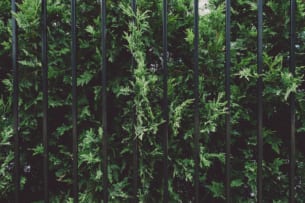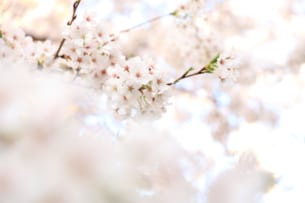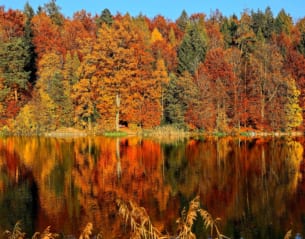Cedar Pollen Forecast 2022, Pollen dispersal to begin in early February
Press Release
Japan Weather Association (JWA) released the Spring Pollen Forecasting in Japan on January 20, 2022.
1. Start of Cedar Pollen Dispersal
This year, cedar pollen season is expected to start in early February in Kyusyu, Shikoku, Chugoku, Tokai and parts of Kanto. Throughout February, the temperature is expected to be normal or lower than average year in many areas of the country, so the beginning of cedar pollen spread is expected to be usual in each region. A small amount of cedar pollen begins to be released even before it is recognized as the start of its dispersal. In areas where the pollen season will begin in early February, it is advisable to start taking measures against pollen as early as January.
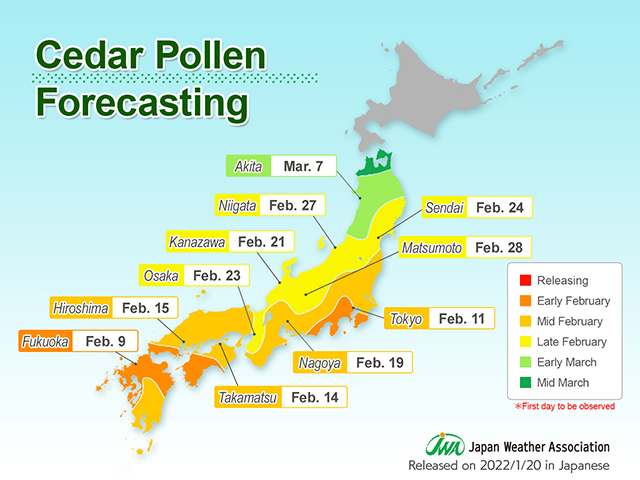
2. Peak Forecast for Each Area
The peak of cedar pollen release is forecasted from late February to early March in Fukuoka and Takamatsu, and early to mid-March in Hiroshima, Osaka, and Nagoya. It will be from early to late March in Kanazawa, Tokyo, and Sendai. JWA estimates the cedar peak season will be about the same as usual in most places.
After the peak of cedar pollen ends, cypress pollen dispersal will start and then the peak will begin. The peak period is expected to be from late March to early April in Fukuoka and Takamatsu, and early April in Hiroshima. In Osaka, Nagoya, and Tokyo, cypress pollen will peak in early to mid-April. JWA estimates the cypress peak season will be about the same as usual. In Kanazawa and Sendai, cypress pollen will be released mainly in April, but compared to other areas the amount is smaller, so it is not expected to have a clear peak.
3. 2022 Season Tendency
In this season, the forecast for pollen dispersion is expected to be the same as usual in Kyushu, Hokuriku, Kanto Koshin, and Tohoku, and less than usual in Shikoku, Chugoku, Kinki, and Tokai. On the other hand, Hokkaido will have much more pollen than usual.**
Compared to the previous season, there are large regional differences in Kyushu and Tohoku, and the amount of releasing in Shikoku, Chugoku, and Kinki is expected to be small. However, Tokai, Hokuriku, Kanto Koshin, and Hokkaido will have more than the previous season. Some areas in Kyushu, Hokuriku, Tohoku and Hokkaido are expected to have very high amount.
** JWA forecasts for pollen dispersal in Hokkaido are based on Japanese white birches.
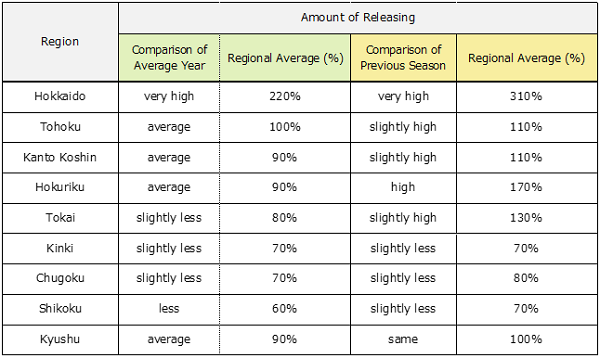
[Explanation of the terms about the amount of releasing]
Very high: 200% or more of the previous season/average year
High: 150% or more but less than 200% of the previous season/average year
Slightly high: 110% or more but less than 150% of the previous season/average year
Average: 90% or more but less than 110% of the previous season/average year
Slightly less: 70% or more but less than 90% of the previous season/average year
Less: 50% or more but less than 70% of the previous season/average year
Very less: less than 50% of the previous season/average year
———————————————————–
Previous season: Amount released in the 2021 season
Average year: Average of the past 10 years (2012-2021)
* PLEASE REFRAIN FROM USING THIS INFORMATION FOR CORPORATE PURPOSES WITHOUT PREMISSION (QUOTATION IN PRESS RELEASES OR USE FOR PROMOTIONAL PURPOSES).
Originally released in Japanese: 2022/01/20
PDF DOWNLOAD:Cedar Pollen Forecast 2022, Pollen dispersal to begin in early February_
